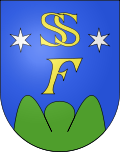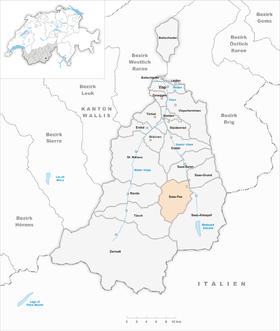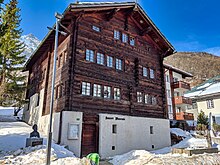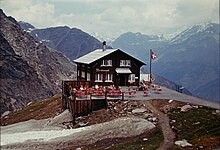Saas-Fee
| Saas-Fee | |
|---|---|
| State : |
|
| Canton : |
|
| District : | Visp |
| BFS no. : | 6290 |
| Postal code : | 3906 |
| UN / LOCODE : | CH SFE |
| Coordinates : | 637 926 / 106587 |
| Height : | 1798 m above sea level M. |
| Height range : | 1556–4542 m above sea level M. |
| Area : | 40.31 km² |
| Residents: | 1564 (December 31, 2018) |
| Population density : | 39 inhabitants per km² |
| Website: | www.3906.ch |
|
View over Saas-Fee |
|
| Location of the municipality | |
Saas-Fee (until 31 December 2006: Saas Fee ) is a municipality and a civic community of the district Visp and a parish of the deanery Visp in the Swiss canton of Valais . In terms of population, Saas-Fee is the largest town in the Saas Valley and the fourth largest in the Visp district after Visp , Zermatt and St. Niklaus .
geography
location
Saas-Fee is located on a high plateau in the Saas Valley , west of the valley floor and above the neighboring villages of Saas-Almagell , Saas-Grund and Saas-Balen . It is the main municipality of the four Saas sub-municipalities. Saas-Fee is framed by the Mischabel mountain range, which comprises a total of 11 four-thousand-meter peaks. The result is a unique panorama, which has made the place known as the “Pearl of the Alps”. Two more four-thousand-meter peaks ( Lagginhorn and Weissmies ) are in the vicinity. The Saas Valley borders directly on Italy , but is separated by a mountain range. There is therefore no direct connection or only via hiking trails.
climate
Due to the favorable location of the Saas Valley, it is sunnier there than in other parts of Switzerland. This often results in pleasant temperatures in winter. It can be very cool at night. The high mountains shield the main weather situation. Even in summer, the average temperatures in Saas-Fee are only around 8 ° C. The average annual rainfall is around 189 mm per month.
language
Saas-Fee is located in the canton of Valais, which is divided into Upper and Lower Valais. While the official language in Lower Valais is French , the population in the Saas Valley (Upper Valais) speaks German . The specific dialect is also known as Wal (li) Serdeutsch . The dialect is sometimes difficult to understand for speakers of Standard German because it has its own grammar and words.
coat of arms
The Saas-Fee coat of arms shows on a blue background, floating above a green three-mountain, the letter F in the middle field. The upper third of the field is occupied by two intertwined letters S, framed by two silver stars. The three letters appeared in gold. The two S are arranged vertically, the letter F is inclined to the right (italic), in the same font, but different in dimensions.
history
- 1256: The Saas Valley is mentioned for the first time in a document
- 1298: Evidence of a first chapel in Saas-Grund
- 1392: The municipality of Saas is divided into the four municipalities of Saas-Fee, Saas-Grund , Saas-Balen and Saas-Almagell
- 1400: The Saas valley separates from Visp in church
- 1535: Construction of the first chapel in Saas-Fee
- 1692: Construction of the St. Antonius chapel near the hamlet of Bidermatten
- 1871: Opening of the first post office
- 1889: Anglican chapel is built
- 1893: Saas-Fee becomes its own parish
- 1893: Construction of a new parish church
- 1923: First electric light in Saas-Fee
- 1930: Creation of the water supply
- 1951: The road to Saas-Fee opens
- 1963: The post bus takes regular courses from Brig to
- 1963: Inauguration of the new village church
- 1969: Inauguration of the Mattmark dam
- 1970: Construction of the indoor swimming pool
- 1973: Opening of the postbus terminal
- 1983: Opening of the Saas Museum
- 1989: Opening of the wastewater treatment plant
- 2007: Opening of the Lötschberg base tunnel to Valais and doubling of the frequency of the Postbus connection
- 2007: Introduction of a new means of transport called “Allalino” (electric “Treno Dotto” with a maximum of 56 seats)
Settlement of the Saas Valley dates back to the Iron Age , the time of the Celts , but it was not until the Roman Emperor Augustus that the Valais and Italy were united, founded cities and traded across the Alps, Monte-Moro and the Antronapass .
The so-called whale migrations began around 700 years ago; many Saas left their homes because of a lack of livelihoods and the prospect of more freedom. They moved over the passes to Italy and settled on the rough altitudes in the Walser settlements of Macugnaga and Antronapiana.
During this time, the Saas Valley was repeatedly overshadowed by storms, floods, diseases and wars (including Napoleon ). Nevertheless, the residents managed to continue their traditions even under the most adverse circumstances.
At the beginning of the 19th century, more and more visitors came to the Saas Valley, and tourism became a steady source of income. The first small guest house was opened in Saas-Grund in 1833, and the first hotel followed in 1856. A tourist infrastructure developed that was primarily geared towards the needs of alpinists. Blacksmiths emerged that specialized in the manufacture of ice axes for mountaineers; they offered themselves as guides for the ascent of the four-thousand-meter peaks or as naturalist guides.
By the middle of the 19th century, almost all four-thousand-meter peaks were climbed, and Pastor Johann Josef Imseng started his first attempts at skiing in 1849 on boards he had made himself. The first ski clubs were founded at the beginning of the 20th century. The road between Saas-Grund and Saas-Fee was opened in 1951, before guests and their luggage were transported to the glacier village on mules .
To this day, despite all the influences, many customs that are deeply rooted in Saas history have been preserved. This includes the self-made traditional costumes that are worn on various occasions as well as the maintenance of traditional music and festivals. Even today there are many traditional costume and music societies that perform at festivals and processions.
The music video for the 1984 Christmas song Last Christmas by the band Wham! was shot in a chalet in Saas Fee.
population
| Population development | |||||||||
|---|---|---|---|---|---|---|---|---|---|
| year | 1850 | 1900 | 1950 | 2000 | 2010 | 2012 | 2014 | 2016 | 2018 |
| Residents | 233 | 280 | 504 | 1454 | 1758 | 1710 | 1632 | 1636 | 1564 |
Economy and tourism

Tourism is the main source of income for the Saas-Fee holiday destination. That is why the municipality attaches great importance to offering a comprehensive range of options for all age groups. After the road opened in 1951, Saas-Fee developed rapidly. Saas-Fee is one of the most popular holiday resorts in Switzerland in summer and winter. The number of beds available for rent in Saas-Fee amounts to a total of 6,600 beds. 2,600 holidaymakers find accommodation in 60 hotels.
- Tourist milestones
- 1833: Opening of the first inn in the Saas Valley, the "Gasthaus zur Sonne" in Saas-Grund
- 1836: Pastor Johann Joseph Imseng sensitizes the population to the slowly emerging tourism
- 1881: The first hotel is built by the municipality, it is called "Dom"
- 1883: Construction of the Hotel Bellevue (later Walliserhof, then Ferienart Resort & Spa, now Walliserhof Grand-Hotel & Spa)
- 1893: Construction of the Beau-Site and Grand Hotel.
- 1901: Construction of the Hotel du Glacier
- 1902: The first skis are seen in Saas-Fee
- 1908: Founding of the «Allalin» ski club
- 1925: Foundation of the tourist association
- 1951: Foundation of the ski school
- 1951: Start of winter sports in Saas-Fee
- 1954: Construction of the aerial cableway on Spielboden
- 1959: Construction of the Spielboden- Längfluh aerial cableway
- 1962: Construction of the gondola lift on Plattjen
- 1969: Construction of the Felskinnbahn and Hannigbahn
- 1984: Opening of the Metro Alpin from Felskinn to Mittelallalin and opening of the provisional Metro-Stübli on Mittelallalin
- 1985: Opening of the revolving restaurant on the Mittelallalin
- 1991: Opening of the 1st section of the Alpin-Express up to mast 4
- 1994: Opening of the 2nd section of the Alpin-Express from mast 4 to Felskinn
- 1998: Creation of the snow-making system
- 2000: Opening of the Feeblitz ( summer toboggan run )
- 2004: Opening of the adventure forest
- 2005: Construction of the new “Meeting Point Morenia” restaurant at mast 4 of the Felskinnbahn
- 2006: Construction of the 6-seater Morenia chairlift
- 2006: Reconstruction / modernization of the Felskinnbahn
- 2016: Reconstruction / modernization of the Spielboden gondola lift
"Free Republic of Holidays"
In October 2011 the "Free Republic of Holidays Saas-Fee" was founded, a marketing campaign by Saastal Marketing AG, which is mainly responsible for tourist campaigns and events in the Saas Valley. With the founding of the "Holiday Republic", the citizens' pass was also introduced, with which one receives discounts on various services. For example, you can use the Postbus free of charge in the winter season and all cable cars except Metro Alpin free of charge in the summer season. The citizens' pass is only available in the accommodation establishments that take part in the campaign.
«Allalin-News»
The Allalin-News are the official media of the Saas Valley. The tourist newspaper informs locals and guests about current events in the village and the region, about problems and solutions, about background information and about events from back then. The Allalin-News also contains information about the tourist offer and the various events.
Award
Mountain Management surveyed a total of 41,864 winter sports enthusiasts directly in numerous ski areas. Overall, Saas-Fee ranks second out of 55 places in Germany, Austria, Switzerland, Italy and France.
Gastronomy and night life
There are over 100 restaurants, pizzerias, cafés and bars in Saas-Fee.
Winter tourism
The ski area offers almost 100 km of slopes of all levels of difficulty. Together with the neighboring areas of Saas-Grund, Saas-Almagell and Saas-Balen, there are a total of 150 kilometers of slopes. 22 lifts transport winter sports enthusiasts and snowshoe hikers up to around 3,500 m. A special feature is the Allalin-Restaurant, the highest revolving restaurant in the world, which can be reached via the highest underground funicular in the world ( Metro Alpin ). The ice pavilion, which has a volume of 5,500 m³, is also unique. Since the slopes of Saas-Fee are mostly exposed to the north and are at high altitudes, they are considered to be very snow-sure throughout the winter season. The longest descent from Mittelallalin to Saas-Fee overcomes a total of 1,778 m difference in altitude over a length of 14 km. In addition to the ski slopes, there are 26 km of cross-country trails, 4 ice rinks, 3 toboggan runs and 60 km of winter hiking trails.
Summer tourism
Saas-Fee and the Saas Valley offer hikers and mountaineers a wide range of activities: for example, the high-altitude path Balfrin to Grächen for those with a head for heights and persevering hikers . The hike measures 18 km and takes about 7 hours. The path is the first stage of the regional route 27 “Swiss Tour Monte Rosa, Saas-Fee - Grächen - Zermatt” from “Wanderland Schweiz”. The whole tour to Zermatt takes a total of 3 days and leads from Grächen via the Europaweg to Zermatt.
Skiing in Saas-Fee is also possible in summer at three ski lifts on the Fee Glacier from the Mittelallalin station at 3,456 m. The revolving restaurant and the largest ice cream pavilion in the world are open during the winter and summer seasons. Thanks to the sheltered location of the Saas Valley, the sun shines four out of five days even in summer. Due to the southern, Mediterranean climate, the tree line is higher than in any other forest in the Alps. The region around Saas-Fee has a total of 350 km of hiking trails and 70 km of mountain bike trails. There are numerous adventure trails, summit tours and special excursion destinations such as the “Feeblitz” summer toboggan run or various via ferratas such as the Alpine Gorge between Saas-Fee and Saas-Grund.
traffic
The road to Saas-Fee was opened in 1951. Saas-Fee is car-free , which is why vehicles must be parked at the village entrance. With the exception of the doctor, fire brigade, garbage disposal, etc., only electric vehicles are allowed to drive in the village . Nonetheless, Saas-Fee has to struggle with traffic problems, because at peak times (for example in the winter season after the slopes close) the heavy electric vehicle traffic affects pedestrian traffic, which fills the narrow streets well.
Saas-Fee is connected to Visp and Brig-Glis by a post bus line.
In the 19th century, plans were made to build a railway line to Saas-Fee, but the Saas people were not prepared to sell the land in question and the railway was instead built to Zermatt (today's Matterhorn-Gotthard Railway ).
sustainability
The municipality of Saas-Fee is committed to sustainability and environmental protection, which is evident not least from the ban on vehicles of all kinds with internal combustion engines. For example, Saas-Fee joined the “Alliance in the Alps” back in 1996. The Alpine Convention is an international agreement for the protection of the natural environment and the promotion of sustainable development in the Alps. The members work in close contact with the population to improve the ecological, social and economic situation in their community and exchange experiences and knowledge with the other members of the network. Further topics and projects are the supply of district heating , waste management (the rubbish bag fee has been in place since 1994 ; Saas-Fee was the first tourist community to introduce this fee to encourage tourists to produce little waste and separate it properly.) or strict location and spatial planning.
Churches
Saas-Fee has numerous Roman Catholic churches and chapels. The main church is the Herz-Jesu-Kirche, built in 1963 . The organ (II / P / 25) with free pipe prospect was built by the Späth Orgelbau AG and has an electric playing and stop mechanism.
In the previous parish church there was a pneumatic organ with a membrane shutter (II / P / 16) from Orgelbau Kuhn AG from 1913 to 1959 .
There is also a Reformed (formerly Anglican) church in Saas-Fee .
Mountains and huts

The Mischabel massif with the cathedral ( 4545 m ) as the highest peak lying entirely on Swiss soil forms the backdrop in the west. The place is surrounded by a good dozen four-thousand-meter peaks . Until 1850 the Fee Glacier reached close to the village boundary at 1880 m above sea level. M. He has withdrawn strongly in the last few decades.
The Mischabelhütte is located above Saas-Fee at 3329 m , a popular starting point for climbing the Lenzspitze and the Nadelgrat . The first hut was built by the AACZ in 1902 and enlarged in 1944. In 1974 an additional hut was built, both huts together offer overnight accommodation for around 130 climbers.
Not far from Saas-Fee is the most popular SAC hut in Switzerland, the Britanniahütte . It was built in 1912 with financial support from the British Association of SAC Members , hence the name Britanniahütte. From here you can climb the Rimpfischhorn and Strahlhorn as well as the Allalinhorn over the Hohlaubgrat.
- List of the highest mountains in the Saas-Fee area with the date of the first ascent
| summit | height | First ascent |
|---|---|---|
| Ulrichshorn | 3925 m | Aug 10, 1848 |
| Ray horn | 4190 m | Aug 15, 1854 |
| Fletschhorn | 3985 m | 28 Aug 1854 |
| Weissmies | 4023 m | Aug 1855 |
| Lagginhorn | 4010 m | Aug 26, 1856 |
| Allalinhorn | 4027 m | Aug 28, 1856 |
| Latelhorn | 3198 m | Aug 28, 1856 |
| Dom | 4545 m | Sep 11 1858 |
| Needle horn | 4327 m | 16 Sep 1858 |
| Rimpfischhorn | 4198 m | Sep 9 1859 |
| Alphubel | 4206 m | Aug 9, 1860 |
| Täschhorn | 4490 m | July 30, 1862 |
| Balfrin | 3795 m | July 6, 1863 |
| Hohberghorn | 4219 m | 1869 |
| Lenzspitze | 4294 m | 1870 |
| Portjen Ridge | 3653 m | Sep 7 1871 |
| Sonnighorn | 3487 m | Aug 1879 |
| Dürrenhorn | 4034 m | Sep 7 1879 |
| Fairy head | 3888 m | July 28, 1883 |
| Pin horn | 4242 m | Aug 8, 1887 |
Personalities
- Arnold Andenmatten (1922–2018), skier and ski instructor
- Daniel Bumann (* 1958), world chef champion and TV chef / presenter (Bumann the restaurant tester)
- Alexander Burgener (1845–1910), mountain guide pioneer and first to climb many peaks in the Alps; was born in Saas-Fee and is buried in Eisten .
- Johann Josef Imseng (1806–1869), pastor and alpinism and tourism pioneer
- Frederik Kalbermatten (* 1981), snowboarder
- Alfons Supersaxo (1926–2005), skier
- Carl Zuckmayer (1896–1977), writer (including Des Teufels General and Der Hauptmann von Köpenick ), lived in Saas-Fee from 1957 until his death
- Matthias Zurbriggen (1856–1917), mountaineer, first to climb the Aconcagua
- Werner Zurbriggen (1931–1980), painter, Way of the Cross & stained glass parish church, wall painting schoolhouse & sgraffito parish hall, Neptun swimming pool.
Twin cities
- Rocca di Cambio , Italy
- Steamboat Springs , Colorado, USA
Trivia
- In 1984 the video clip for the world hit Last Christmas from Wham! turned.
literature
- Paul Martone: Saas-Fee. In: Historical Lexicon of Switzerland . 2012 .
- Werner Imseng: The summer in Saas-Fee. Your holiday guide for walks, hikes and getting to know the country and people of the Saas Valley. 4th, improved edition. Rotten Verlag, Visp 1995, DNB 947459308 .
Web links
- Saas-Fee on the ETHorama platform
- Official website of the municipality of Saas-Fee
- Saas-Fee Historical Archive Saas Valley
Individual evidence
- ↑ Permanent and non-permanent resident population by year, canton, district, municipality, population type and gender (permanent resident population). In: bfs. admin.ch . Federal Statistical Office (FSO), August 31, 2019, accessed on December 22, 2019 .
- ↑ Geographical location of Saas-Fees. Saas-Fee municipality, accessed on February 25, 2013 .
- ↑ Saas-Fee climate diagram. Mapped Planet. Retrieved February 25, 2013 .
- ^ Saas-Fee municipal coat of arms. Saas-Fee municipality, accessed on February 25, 2013 .
- ↑ Hotels and holiday apartments in Saas-Fee. Saas-Fee website, accessed June 11, 2019.
- ↑ Saas-Fee ski area on ETHorama
- ↑ sustainability. Saas-Fee municipality, accessed on February 25, 2013 .
- ^ Rudolf Bruhin: The Upper Valais as an organ landscape. (PDF) Retrieved April 2, 2016 .
- ^ Rudolf Bruhin: The organs of the Upper Valais. (PDF) Retrieved April 2, 2016 .
- ↑ Sonnighorn on ETHorama











